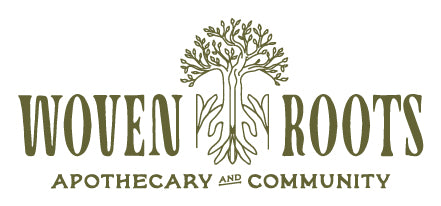We recently had the pleasure of stumbling upon Black Cohosh (Actaea racemosa) while wandering through the woods. It was a moment of pure joy for me. I have worked with this herb in different forms, but I had never seen them in full form or in their natural habitat. I greeted them with such delight and wonder – "It’s so nice to meet you in person!". I wasn’t going to remove any of this particular native plant from their home because they are an at-risk plant species and I did not know this land or this specific population. This encounter reminded me of the delicate balance we must maintain when interacting with these precious wild plants.
In the early days of my journey into herbalism, wildcrafting was all the rage. Harvesting herbs directly from their natural habitats was seen as a badge of honor, and wildcrafted herbs were prized above all else. Everyone seemed to be wildcrafting as much as they could, possibly driven by various factors like demand, the allure of these "wild" herbs, the low cost involved, self-reliance, a focus on local, or simply motivated by the deep sense of ancestral connection that can be felt when participating in this ancient practice. Whatever the reasons, there are a lot more people on this planet putting a lot more demand on natural resources than in the days of hunters and gatherers, and there are a lot less available livable habitats.
As herbalism gained popularity, the widespread practice of wildcrafting began to take its toll on ecosystems. It wasn’t long before many people realized that our enthusiastic harvesting was pushing some wild herbs towards the brink of extinction. This awareness grew thanks to the efforts of organizations like the United Plant Savers, who highlighted the environmental impact of these unchecked practices. We realized that some wild herbs were being decimated due to over-harvesting, leading many to rethink their approach. Not only would we humans lose the ability to benefit from the plants’ medicine, but so would all the other creatures who rely on the plant for their survival. The plants’ native habitat would lose an important member of its interconnected community and, maybe most importantly, the species deserves to continue living and enjoying this awe-inspiring planet we all call home.
I, along with many others in the herbal community, began to see the importance of harvesting herbs with more awareness. The practice of wildcrafting became less celebrated as we recognized its potentially unsustainable nature. Today, the focus has shifted more towards cultivating herbs on small farms and forests, or home gardens, reducing the pressure on local ecosystems.
While I continue to seek out herbs in the wild, my primary intention has changed. Instead of focusing on harvesting, I now relish the opportunity to see and marvel at these plant friends in their home and full glory. It’s a chance to connect with them, learn from them, and appreciate their beauty and the magnificent ways they are in important relationships with their local community. If I am looking to harvest, I do so with much more awareness and knowledge of how to harvest responsibly. And if the plant is at-risk or I am not in need of the herb, I wave hi (pretty excitedly) and just feel honored to get to be in their home and presence for a few moments. This heartwarming encounter usually makes me even more confident about my responsibility to help protect them. So if you happen to see Black Cohosh in the wild, please say “hi!” for me.
The concept of reciprocity has become central to my practice. Plants do so much for us, offering their medicine in so many ways and enhancing our well-being. It’s important to me that I give back by protecting and caring for them. This means not only ensuring their survival but also fostering an authentic relationship with the plants I work with as an herbalist. They deserve our respect and protection, not to be decimated for our use.
Wildcrafting remains a sacred practice and an integral part of herbalism. I certainly don’t want to claim that the practice is all bad. The key is to do it responsibly, with an understanding of the impact on the environment. Resources from the UPS and other organizations provide valuable guidance on how to wildcraft with care and awareness and which species to avoid when wildcrafting. Please check out the many resources available at https://unitedplantsavers.org/
For me, healing happens through connection. Herbalism offers so many ways to experience and foster connection that doesn’t require ingesting herbs. I find that simply sitting with them, witnessing them, delighting in them, and learning from them can be just as supportive and healing. I have also really come to appreciate the power of growing my own herbs– caring for them, watching them grow…and sure, sometimes I eventually harvest them. And other times I simply enjoy being in relationship with them.
I think it’s an interesting question: what can you learn from these vibrant, living plant beings without harvesting them?
Whether an herb is wildcrafted or cultivated, it is so important to know where your herbs come from. For me, it is invaluable to ensure they are harvested and cultivated with love, respect, and responsibility. This conscientious approach supports both the plants and the ecosystems they inhabit, ensuring that we can continue to enjoy them (and their benefits) for generations to come.
Ultimately, herbalism is about building a reciprocal relationship with the natural world, honoring the plants that heal us and help us, and fostering sustainable practices that respect the delicate balance of our ecosystems.

